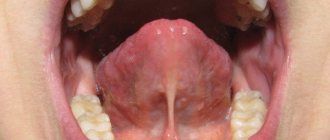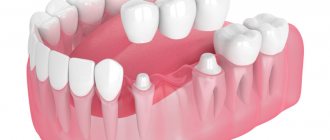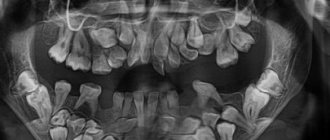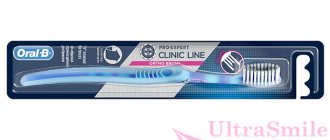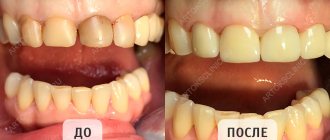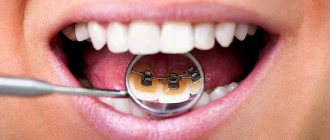Braces are divided into types according to different parameters: functionality, installation principle, material, etc. Usually the doctor invites the patient to choose an orthodontic design based on medical indications and his financial capabilities. How to make the right choice? Let's find out what types of braces there are and how they differ from each other.
In this article
- What types of braces are there?
- Metal braces
- Plastic braces
- Ceramic braces
- Sapphire braces
- Types of bracket systems according to the method of fixation
- Types of braces according to the location of fixation
- Other types of braces
- Which braces to choose
A brace system is an orthodontic structure that is used to correct bite pathologies. Today, this is one of the most effective ways to straighten teeth, with which you can cure almost any disease associated with improper jaw development and dental growth.
Braces consist of many parts, the main ones being the locks and the arch. The first ones are attached to the enamel using a special dental glue. Throughout the entire time you wear orthodontic braces, the locks remain in the places to which they were glued. A metal arc is passed through them. It puts pressure on the jaw and dentition, which helps align the teeth.
Braces are installed for a period of several months to 2-3 years, depending on the pathology of the bite. Every 1-3 months, the patient comes to see the orthodontist to tighten the arch and increase the pressure on the teeth. This continues until they take the correct position.
The duration of orthodontic treatment is determined not only by medical indications, but also by the type of braces. Factors such as comfort, aesthetics, safety, etc. also depend on the type of system. There are many options for installing orthodontic structures. Often, after an examination, the doctor invites the patient to choose the type of braces himself, based on his financial capabilities, lifestyle, profession, etc.
We will help you make the right choice and describe all the types of orthodontic brackets used today in modern dentistry.
What types of braces are there?
Bracket systems are classified according to several bases:
- by material: metal, plastic, ceramics and sapphire;
- by type of fixation: ligature and non-ligature (self-ligating);
- by place of installation: lingual and vestibular.
Each bracket system has its own distinctive properties, advantages and disadvantages. We will describe each type separately.
Metal braces
Metal brackets for correcting bites are the most common type of braces, which appeared more than 70 years ago. Over time, the design has been modified and modernized, but the principle of its structure has remained the same. Metal braces systems consist entirely of metal, mainly medical steel. This material is very durable, so you can achieve the fastest results with it.
It also has other advantages:
- can correct almost any malocclusion pathology;
- are installed both on the outside and on the inside of the teeth;
- are included in the middle price category (more expensive than plastic, but cheaper than ceramics).
Metal braces also have disadvantages. Among them:
- require adaptation, during which they may rub the oral mucosa;
- affect the patient’s diction;
- low aesthetic properties;
- Not suitable for people with individual metal intolerance.
Often such braces are rejected because they are unsightly. However, in the absence of contraindications, they can be placed on the back side of the dentition.
Metal braces are not only steel, but also titanium. The latter are lighter and more durable, and also have high functionality. In addition, they are biocompatible and therefore do not cause allergies. They are installed for allergy sufferers and patients with gastrointestinal problems. Prices for titanium bracket systems are slightly higher than for steel structures.
Indications for installation of vestibular braces
The main reason for orthodontic correction is the desire to get an attractive and healthy smile, which is natural for every person. As for medical factors, the presence of which is considered a reason for prescribing treatment, they include:
- The need to correct the bite;
- Correction of speech defects;
- Correction of occlusal closure;
- Crowding of the frontal incisors;
- Interdental gaps - trema and diastema;
- Curvature of one or more teeth;
- Hypertrophied development of one of the jaws in relation to the other;
- Diagnosed chewing dysfunction;
- Aesthetic and other factors.
The choice of a corrective device is determined by the specifics of the identified pathology.
Plastic braces
All types of braces are connected by a metal arch, due to which the correction is carried out. The design may have plastic locks, screws and other parts, but the arc will still be made of metal. Plastic braces are a good alternative to steel and titanium braces when it comes to aesthetics. However, in terms of efficiency, plastic products are much inferior to metal ones. We list the main advantages of plastic braces:
- low cost;
- stealth;
- short period of adaptation.
Typically, such systems are installed on children or patients with minor defects. However, plastic braces are not suitable for people who play sports or have severe occlusion diseases. This is due to the following disadvantages of plastic braces:
- have low strength;
- are not able to create strong pressure;
- are installed only on the outside of the teeth;
- quickly stain and darken due to eating and smoking.
Plastic braces can be single-colored or multi-colored. If desired, the orthodontist can prepare a design with locks of different colors: blue, red, purple, yellow, etc. Such brackets look unusual. As some people believe, if there is no way to hide your braces from others, make them original.
Ceramic braces
Braces are also more invisible and aesthetically pleasing if they are made of ceramic. There are many varieties of ceramic materials that differ from each other in shades. The doctor can choose a design that will completely match the natural shade of the teeth. Ceramic braces can only be noticed at close range. If you paint the metal arch white, the staples will become even less noticeable.
The main advantages of braces made from ceramics:
- high aesthetics;
- short adaptation period;
- do not injure the buccal mucosa;
- strength is higher than that of plastic.
The disadvantages of such systems include:
- difficulty in dismantling (may crack);
- darken from tobacco smoke and dyes;
- are not installed on the inside of the teeth;
- high price.
Typically, ceramic braces are chosen by people for whom it is important to hide orthodontic treatment from others.
Prices for braces in our clinic
The price of a braces system consists of several components:
- type of orthodontic structure
- material from which the braces are made (metal, ceramic, sapphire)
- manufacturing company
INTAN Implantation and Dentistry Centers offer an objective price/quality ratio for dental correction in St. Petersburg. Our policy is honest, low prices , which means you won’t find hidden fees or fine print in the contract.
In addition to the above factors that influence the final cost of orthodontic treatment, the price formation is influenced by the initial condition of the patient’s oral cavity, the need for preliminary preparation, and the frequency of correction during treatment.
You can consult a dentist about the details of installing a braces system, who will offer several options that are suitable specifically for your situation. To avoid problems, it is better to make the final choice together with your doctor.
Sapphire braces
The sapphire bracket system is the most expensive, as it is made from artificial sapphire. This material has the highest strength. It makes it possible to produce a structure for the treatment of severe pathologies. But the main advantage of sapphire staples is invisibility. They are completely transparent, so they are practically invisible to others. If a patient orders a white arch, few will realize that he is undergoing treatment from an orthodontist. There are other advantages to such bracket systems:
- have hypoallergenic properties;
- allow you to quickly adapt;
- do not cause problems with diction;
- more resistant to dyes.
The main disadvantage of the sapphire system is its high cost. It is also impossible to install it on the inside of the dentition.
Often the patient has to choose between metal and plastic structures, which are not as expensive as ceramic and sapphire. However, the material of the staples is not the only basis on which they are classified. Let's find out what other types of braces exist.
Indications and contraindications
The brace system is indicated for malocclusion. Uneven teeth are considered the main indication, but in addition to this, doctors recommend installing braces in the following cases:
- Curled teeth. If the teeth are spaced too tightly, the oral microflora will develop faster. At the same time, with increasing load, the enamel becomes thinner and the risk of caries increases.
- Disproportional development of the jaws. If the defect is left unattended, the chewing process may be disrupted. The cause of this phenomenon may be the bad habit of chewing pencils or sucking fingers.
- Dystopia. This term means a displaced position of a tooth - its extension from a row or rotation.
- Gaps between teeth. Braces can be used to restore normal dental density. The problem may be related to tooth loss or may be genetic.
Installation of braces is not possible if the following contraindications are present: too many teeth are missing, diseases of the immune system, blood diseases, endocrine diseases, HIV, neuropsychiatric disorders have been identified.
Types of bracket systems according to the method of fixation
Depending on the type of fixation, braces can be ligature or non-ligature. Ligatures are small elastic bands with which the arch is fixed to the braces. Instead of rubber bands, the orthodontist may use thin wire made of aluminum, steel or silver. Systems that use ligatures are called ligature systems.
Non-ligature or self-ligating braces are not much different from ligature braces, they just do not use this elastic band. In the groove of the structure itself there is a cover or lock, which allows you to fix the arc on the system.
Which braces are best to choose for correction? There is not much difference between them. They cope with any bite pathologies with equal efficiency. However, there are still minor differences. Ligature systems need to be tightened approximately once a month, and non-ligature systems - once every 2-3 months. If a person lives far from a dental clinic, it is better for him to install self-ligating structures. They are also suitable for those people who travel frequently and cannot come to the dentist every month.
Ligature and non-ligature braces can be plastic, metal, ceramic and sapphire. If you want to save money, but not at the expense of treatment and aesthetics, you can choose plastic ligature staples with multi-colored ligatures. Sapphire self-ligating systems will look most aesthetically pleasing.
Types of braces according to the location of fixation
Depending on the place of installation, braces are divided into vestibular and lingual. The first ones are installed on the outside of the teeth, and the second ones on the inside. Which of these two designs is better? Each system has its pros and cons.
Vestibular or external braces are inferior to lingual braces in aesthetics. But they are suitable for any malocclusion diseases. In addition, they come in metal, sapphire, plastic and ceramic, while lingual structures are made only from metal. Other advantages of external braces:
- easier to care for;
- defects are corrected faster;
- less rubbing of the oral mucosa.
The main advantage of lingual braces is their invisibility. They are chosen by people who have to constantly negotiate, speak in public, etc. They are also often played for children. The disadvantages of such systems are as follows:
- difficult to care for;
- rub the tongue;
- greatly affect diction.
Many people never get used to the fact that their tongue is constantly in contact with metal. Ulcers and wounds often appear on it, which hurt and bleed. Also, a person with lingual braces has a lisp throughout orthodontic treatment. Not everyone can cope with these problems psychologically.
If we talk about effectiveness, then with the help of lingual and vestibular braces you can achieve the same result if the treatment is modeled correctly. Installation of internal structures is a more labor-intensive process, but an experienced orthodontist will cope with this task without any complications.
Photos of teeth before and after braces
Trust in a doctor consists of many factors: reviews and recommendations from friends, a well-conducted consultation, doctor’s certificates, diplomas and awards, photos of clinical cases “before” and “after” of treatment with braces published on the Internet. Doctors actively maintain groups on social networks and blogs on clinic websites, post videos on YouTube, and post photographs with the results of orthodontic treatment.
deep bite
high crowding, flat profile
moderate crowding, asymmetry
high degree of crowding, open bite, posterior crossbite
case without removal
bilateral crossbite with a high degree of crowding of the anterior group of teeth in the upper jaw
Other types of braces
There are so-called hybrid or combined designs that combine the features of different types of braces. Examples of such systems are:
- lingual-vestibular;
- metal-ceramic;
- metal-sapphire;
- ligature-self-ligating.
By combining the properties of different types of braces, it is possible to reduce the cost of the structure, improve its aesthetics, increase functionality, etc. This depends on the needs of the patient. These staples are more difficult to make and may take longer to prepare.
What is more expensive - braces or aligners?
In some individual cases, expensive branded aligners may be more expensive than cheap braces, especially with long-term treatment involving many stages. But if the comparison is made correctly, comparing cases of the same degree of complexity, then the difference in the price of braces or aligners will either be minimal, or even aligners will be more profitable.
Imported mouthguards from foreign manufacturers are more expensive. Our clinic cooperates with Star Smile, a leading domestic manufacturer of aligners, which, with completely similar quality, have a much lower price. This allows us to offer treatment for malocclusion using aligners at the most affordable prices.
Therefore, to the question: what to choose: braces or aligners? – our doctors answer unequivocally – choose aligners. This will provide greater comfort during treatment, better aesthetics and will be much more profitable.
Which braces to choose
The choice of braces is determined primarily by medical indications. The financial issue is also important, but not decisive. A person must take into account various factors, including his profession and lifestyle. People who lead an active lifestyle and play sports are more suitable for ceramic and metal products, while for children and public figures - lingual ones. Sapphire structures are considered an ideal option for everyone, which is why they are more expensive than other types of braces.
However, it is worth understanding that the effectiveness of treatment depends not only on the type of staples. It is important how accurately the patient follows the dentist’s recommendations. If you do not adhere to a diet and neglect hygiene rules, caries, gingivitis and other oral diseases may develop. Sometimes you have to remove braces to cure these ailments and begin to correct your bite again.
It is not difficult to prevent such complications. Carefully care for your teeth and orthodontic structures, using special brushes, brushes, dental floss and rinses. Orthodontists also recommend using irrigators for additional cleaning of the oral cavity. Choose models with braces care attachments, such as Revyline RL 100 or Donfeel OR-800.
Don't forget about scheduled visits to your doctor. Purchase hygiene products after consulting a specialist.
The result of orthodontic treatment
The goal of treatment with braces is to form the correct closure of teeth in the sagittal, vertical and transversal planes. In 1972, physician Lawrence Andrews formulated six keys to optimal occlusion in the permanent dentition. When correcting incorrect position of teeth and correcting the relationship between the upper and lower jaw, orthodontists of the 21st century are guided by the signs identified by the researcher:
- fissure-tubercle contact of the molars of the upper and lower jaws;
- crown angulation;
- crown inclination;
- lack of tooth rotation;
- tight approximal contacts;
- parallelism of the occlusal plane of the upper and lower jaw to the true horizontal.
The orthodontist forms the correct occlusion, improves the torque of the teeth and the exposure of the incisors. As a result of treatment, the doctor expands the dentition and creates an ideal smile.
What is an ideal smile? When a person smiles, the anterior teeth, premolars, and mesial surfaces of the first molars are visible. The cutting edges of the incisors and canines of the upper jaw follow the contours of the lower lip and form the arch of the smile.
result of bite correction
